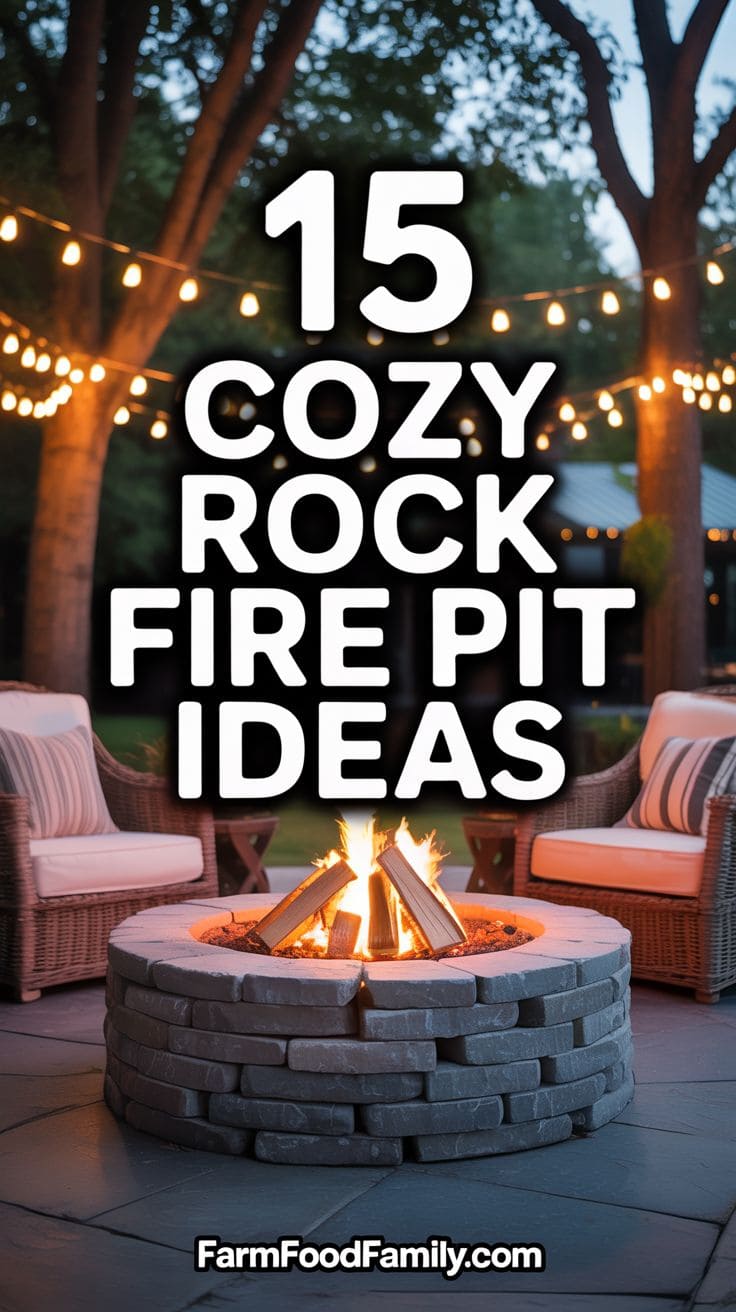Rock fire pits blend natural charm with cozy outdoor functionality, offering a timeless focal point for any backyard or patio.
They can range from rugged and rustic to artfully polished, depending on the type of stone, layout, and overall landscape design.
Rocks not only provide a durable and fire-safe material for the pit itself, but they also contribute organic texture and grounding beauty to the space.
These rock fire pit ideas explore creative ways to use rocks to design a fire pit that feels deeply integrated with your surroundings.

1. Fieldstone Circle Fire Pit with Log Seating

This fire pit has a classic and inviting appeal, with huge fieldstones arranged in a circular arrangement that blends seamlessly into practically any outdoor scene.
Choose uneven stones to give the pit a rustic, handcrafted appearance.
Leave the stones uncut for a more rustic appearance, or chisel the edges for a little cleaner finish. To increase drainage and safety, set the fire pit on a base of gravel or sand.
Arrange split log benches or rough-hewn wooden stumps around it to add to the rustic look.
This sort of fire pit works well in wooded or grassland areas and requires little maintenance.
The fieldstone design has a raw, unpolished quality that works well with mountain cabins or country scenery.



2. Flat Top Stone Fire Pit

To construct an elegant-looking smooth-walled fire pit, use narrow, flat stones such as slate or bluestone.
This style is ideal for pairing with a stone or paver patio. Surround the pit with complementary tones in a circular or square design to merge it effortlessly into the landscape.
Stack the slate carefully to create a tiered, horizontal look that elevates the fire pit’s visual appeal without overwhelming your space.
The flat surfaces also provide ledges for resting mugs, plates, and marshmallow sticks.
Include low-profile seating options such as built-in stone benches with cushions or earth-toned Adirondack chairs.
This polished design complements both modern and historic homes, offering a more refined perspective on natural stone.



3. Lava Rock Fire Pit with Rough Rocks

For a volcanic, elemental aesthetic, construct your fire pit with large rocks around the perimeter and fill the center with black or red lava rock.
The rocks can be irregular in shape and size to create a more organic look, resembling a natural crater or hot spring.
Use propane or natural gas lines to fire the lava rock, which produces mesmerizing, flickering flames without smoke.
The bold contrast between rough stone and fiery lava rock creates dramatic visuals, perfect for contemporary desert or mountain landscapes.
For seating, place weathered stone slabs or large flat boulders around the pit. Accent with desert plants like agave or ornamental grasses to enhance the earthy atmosphere.



4. River Rock Fire Pit

Build a fire pit out of smooth river rocks to give your space a comfortable, cave-like ambiance.
Consider creating a shallow pit in your yard, lining it with heat-resistant pavers or gravel, and stacking medium-sized river stones along the edge to form a low wall from the ground.
The rounded roughness of river boulders provides the fire pit with a soft, natural flow, making it ideal for creekside properties or forested yards.
Add comfy, weather-resistant cushions or stone-built seating to the pit’s retaining walls to create a hidden gathering space.
String a few Edison bulbs high on poles or trees to provide a nocturnal glow. This set up promotes closeness and relaxation while highlighting the smooth elegance of water-worn stone.



5. Cobblestone Fire Pit with Crushed Gravel Seating Area

Craft a low, circular fire pit using uniform cobblestones mortared together for a tidy and structured finish.
This design has a classic garden feel, perfect for suburban backyards or cottage gardens.
The cobblestone gives the fire pit a timeless, almost European aesthetic while remaining low-maintenance and durable.
It’s ideal for intimate, cozy spaces and great for pairing with afternoon tea or evening storytelling.



6. Classic Circular Rock Fire Pit

7. Rustic Stone Fire Pit

8. Modern Square Rock Fire Pit

9. Sunken Rock Fire Pit

10. Raised Rock Fire Pit

11. Rock Fire Pit with Seating Wall

12. Portable Rock Fire Pit

13. Rock Fire Pit with Grill

14. Multi-Level Rock Fire Pit

15. Decorative Rock Fire Pit

16. Large Gathering Rock Fire Pit

17. Rock Fire Pit with Natural Surroundings

18. DIY Rock Fire Pit

19. Rock Fire Pit with Water Feature

20. Custom-Shaped Rock Fire Pit

Conclusion






Rock fire pits are more than just functional heat sources as they’re sculptural anchors that shape outdoor spaces into welcoming, year-round havens. Each of these ideas brings its own character and emotion to a backyard setting.
Whether your style leans toward minimal elegance, woodland whimsy, or bold landscape drama, a well-designed rock fire pit is a timeless investment in atmosphere, comfort, and beauty.
If you liked these ideas, leave a comment below and share it with friends!

